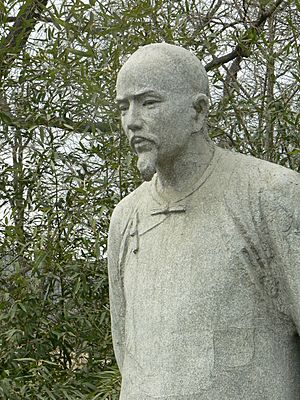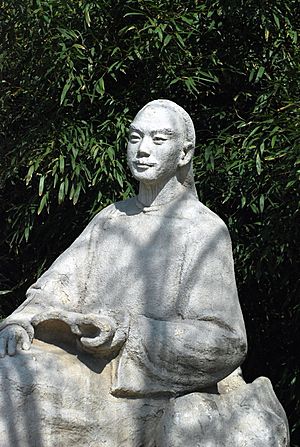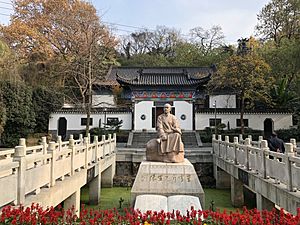Cao Xueqin facts for kids
Quick facts for kids
Cao Xueqin
|
|||||||||||||||||||||
|---|---|---|---|---|---|---|---|---|---|---|---|---|---|---|---|---|---|---|---|---|---|

Statue of Cao Xueqin in Beijing
|
|||||||||||||||||||||
| Born | 4 April 1710 Nanjing, China |
||||||||||||||||||||
| Died | 10 June 1765 (aged 55) Beijing |
||||||||||||||||||||
| Occupation | Novelist, poet, painter, philosopher | ||||||||||||||||||||
| Chinese name | |||||||||||||||||||||
| Chinese | 曹雪芹 | ||||||||||||||||||||
|
|||||||||||||||||||||
| Courtesy name | |||||||||||||||||||||
| Traditional Chinese | 夢阮 | ||||||||||||||||||||
| Simplified Chinese | 梦阮 | ||||||||||||||||||||
|
|||||||||||||||||||||
Cáo Xuěqín ([tsʰǎu̯ ɕy̯ètɕʰǐn] TSOW-_-SH'WEH-chin; 4 April 1710 — 10 June 1765) was a famous Chinese novelist and poet. He lived during the Qing dynasty, a time when emperors ruled China. Cao Xueqin is best known for writing Dream of the Red Chamber. This book is considered one of the Four Great Classical Novels of Chinese literature. His real name was Cáo Zhān, and his courtesy name was Mèngruǎn.
Contents
Cao Xueqin's Family History
Cao Xueqin was born into an important Han Chinese family. His ancestors started working for the Manchu royal family in the early 1600s. They were like special helpers or bondservants to the emperor.
His family became well-known for their military service. They were part of the Plain White Banner, which was a group of soldiers in the Eight Banners. This service brought them respect and wealth.
Later, the Plain White Banner came directly under the Qing emperor's control. The Cao family then started working in civil jobs for the Imperial Household Department. This department managed the emperor's personal affairs.
How the Cao Family Became Powerful
The Cao family's power grew a lot during the reign of the Kangxi Emperor. In 1663, Kangxi appointed Cao Xueqin's great-grandfather, Cao Xi, as the Commissioner of Imperial Textiles. This important job was in Jiangning (which is Nanjing today). So, the family moved there.
When Cao Xi died in 1684, his son, Cao Yin, took over the job. Cao Yin was a close friend of Emperor Kangxi. He was also a very smart writer and loved collecting books. The Cao family became so rich and important that they hosted Emperor Kangxi four times when he visited the Nanjing area.
In 1705, Emperor Kangxi even asked Cao Yin, who was a poet himself, to collect all the surviving poems from the Tang Dynasty. This huge project resulted in a book called The Complete Poems of the Tang.
The Family's Downfall
The Cao family's good fortune continued until Emperor Kangxi died. When the Yongzheng Emperor took the throne, things changed. In 1727, Yongzheng took away the Cao family's properties. Cao Fu, who was then in charge, was also put in jail for a short time. This happened because of problems with how they managed money.
When Cao Fu was released a year later, the family had lost most of their wealth. They were forced to move to Beijing. Cao Xueqin was still a young child at this time. He and his family lived in poverty after their move.
Cao Xueqin's Life as a Writer
We don't have many records about Cao Xueqin's early life. Scholars still discuss his exact birth date. We know he was around 40 to 50 years old when he died. It's also not fully clear if he was the son of Cao Fu or Cao Yong.
Most of what we know about Cao comes from his friends. Cao Xueqin eventually settled in the countryside west of Beijing. He spent most of his later years there, living in poverty. He sometimes sold his paintings to make money.
Friends remembered him as a very smart and talented person. He spent about ten years working hard on his most famous book, Dream of the Red Chamber. His family's change from being very rich to becoming poor deeply affected him. This experience helped him understand life's difficulties and inspired his writing.
His friends also praised his paintings, especially those of cliffs and rocks. They also admired his original Chinese poetry. Cao Xueqin died around 1763 or 1764. He left his novel almost finished. Some parts of his handwritten book were lost after friends borrowed them. He had a wife, but his son had passed away before him.
The Legacy of Dream of the Red Chamber
Cao Xueqin became famous after his death because of his great novel. The book is said to be written with "blood and tears." It tells the story of a powerful family at their best and their later downfall.
After Cao died suddenly, a small group of his family and friends were busy copying his handwritten book. About 80 chapters of this work were passed around in Beijing. These handwritten copies quickly became very valuable.
In 1791, two people named Cheng Weiyuan and Gao E published a "complete" 120-chapter version of the novel. They said they had access to Cao's notes. This was the first time the book was printed using woodblock printing. It was reprinted a year later with more changes. This 120-chapter version is the one most widely read today. However, many modern scholars wonder if Cao Xueqin really wrote the last 40 chapters himself.
Even today, Cao Xueqin continues to inspire new Chinese writers and poets. For example, the poet An Qi wrote a poem called To Cao Xueqin to honor him.
See also
 In Spanish: Cao Xueqin para niños
In Spanish: Cao Xueqin para niños
- Chinese literature
- List of Chinese authors



